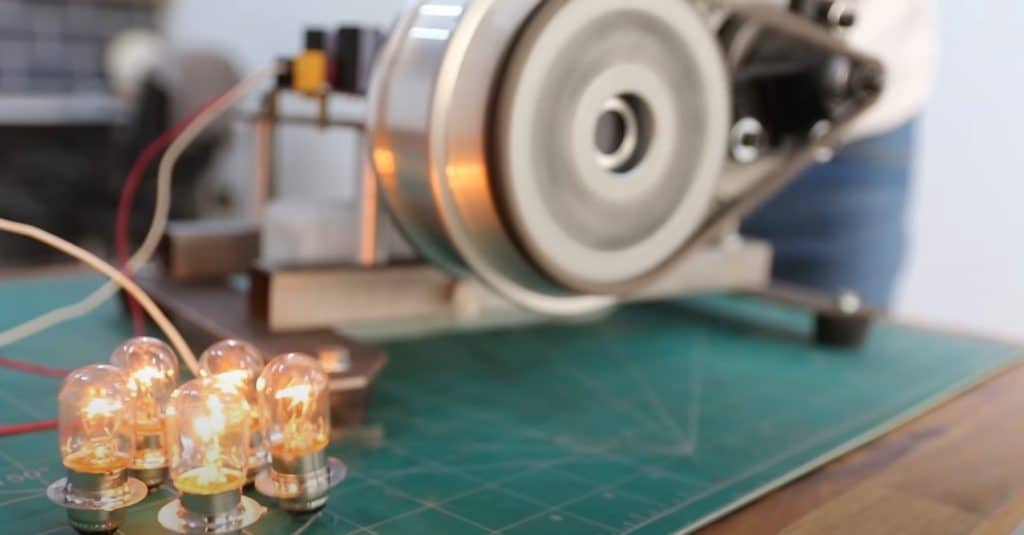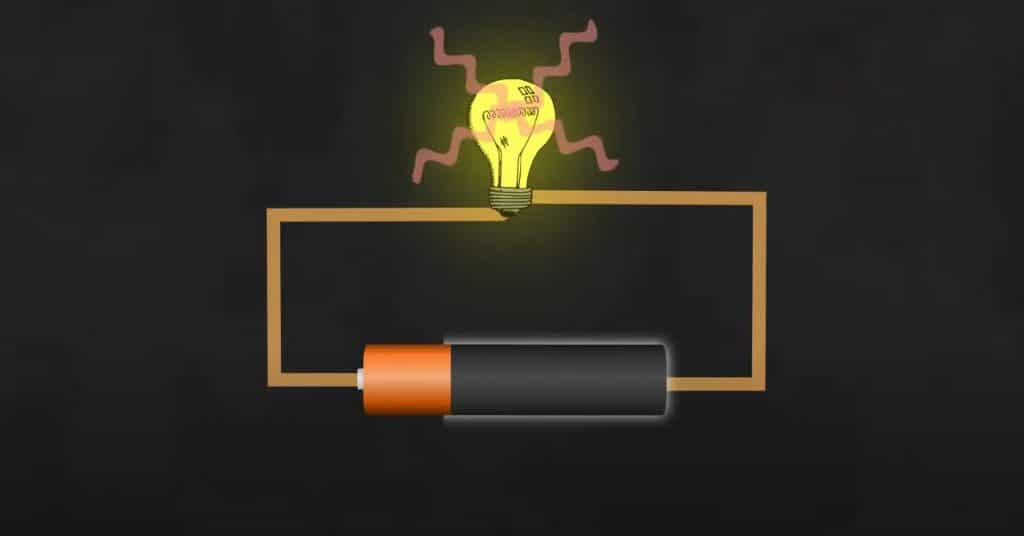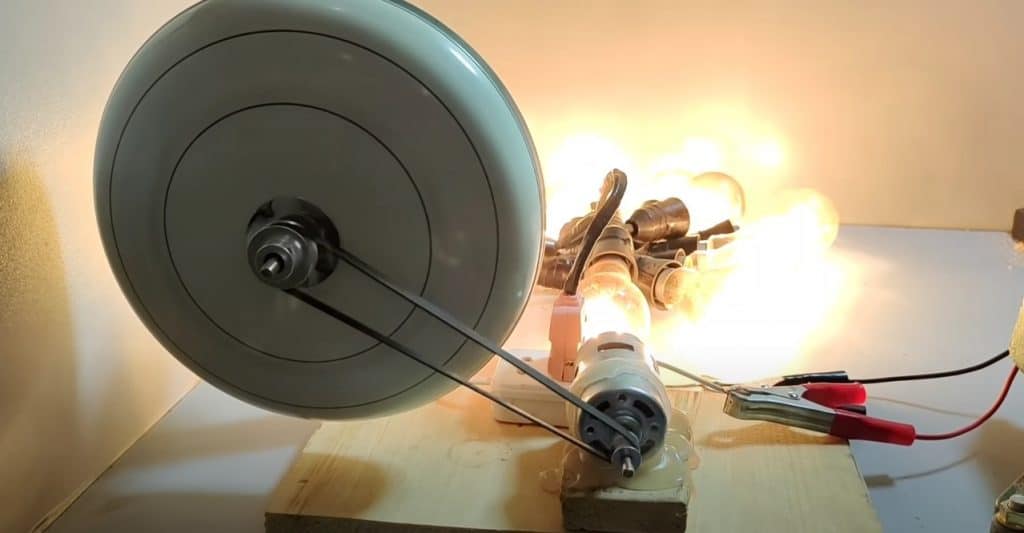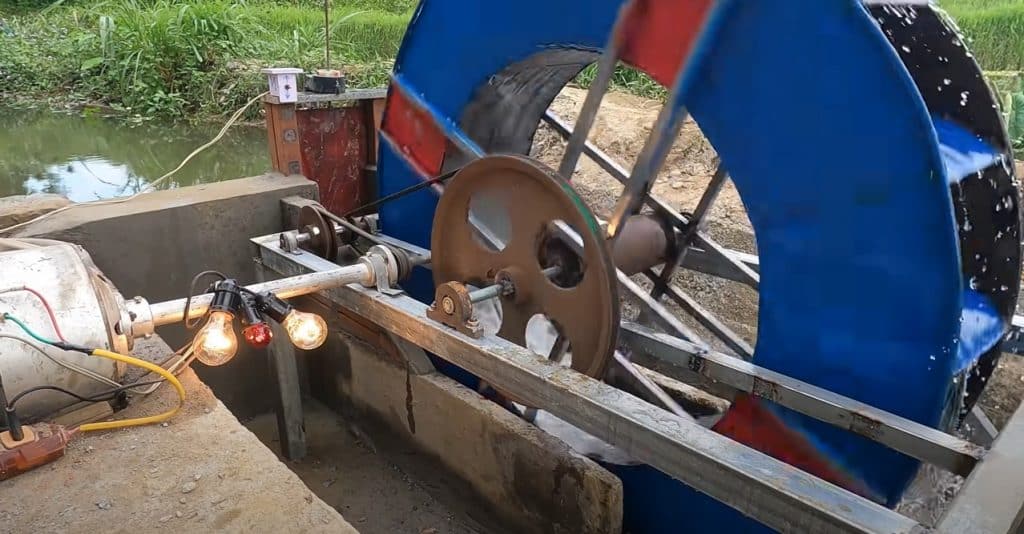A DIY generator is a must for any survivalist. At times, energy is a crucial factor in survival. But what if there is no more municipal electricity in miles around and your batteries have long gone dead? You should think of making a DIY solar energy generator to heat your living space in case of a long-term outage. Read on, and you will find out about solar panels and their role in your future survival. Don’t miss out on your knowledge of solar power: it might save your life one day.
Read the instructable and find out about voltage, learn what rpm is and how you can a lot of electricity using low rpm, find out how to make motors at home without using municipal power lines. The information will be helpful to those who want to create their own DIY generator project in any place in the world.
There are many reasons to think about creating your DIY generator system that will not be connected to the general power supply network. Let us consider the major ones:
- For example, a long-term emergency will cause the network to crash, and you will need emergency power for your EMP safety.
- Or you live far from a settlement without the benefits of civilization and prefer more to use nature’s resources.
- Or maybe you don’t want to be dependent on municipal services.
- You may also need your own generator if you use modern electric cars and need more instructable information on making a DIY car battery.
- With your own electric DIY generator, you can avoid paying an extra price for electric battery connections and not spending money on municipal energy.
- You may also be more curious and build your alternator with a source of light, just out of your love of science and information.
- And finally, it would be a great solution for those who prepare for living off the grid.
It is not so important what exactly your goal is. Everyone can find reasons to use an electrical DIY generator like this one. Now we cannot imagine life without a burning light bulb or a charging phone, and many appliances for life and elementary cooking require voltage. But this has not always been the case. For many centuries people lived and survived without sources of light. They used candles, fireplaces, and wood or coal stoves, slept under three blankets, and so on. Get best extension cord for your DIY generator!
But let’s be honest, now the living standards and our job are very different from what they were in the last century. To get where we are at, we have simplified the system of surviving and consuming huge amounts of accessories, like wax to make candles; we reduced deforestation to provide heat, and we can keep food fresh for a much longer time thanks to refrigerators and freezers, and much more by inventing electrical power. It has become easier to live, and few can argue with this.
Essential Means of Survival

If, before reading, you did not think about building a DIY generator with your own hands, now is the time because, for this, you do not need to be a genius in the field of electrical engineering. Even a special education is not required. As sources of such information, there exist the Internet and our blog.
Of course, you can buy a ready-made stand-alone power DIY generator and use it in most cases when you may need power. But situations are different and, perhaps, you will need it tomorrow, and there will be no opportunity to buy it. Besides, the feeling of pride in a self-built generator will only have a positive effect.
Therefore, knowing how to build a generator system yourself is already an advantage during your off the grid survival rather than not being able to make one, even if at the moment it seems like a silly and unnecessary undertaking. Survival books teach us quite the opposite.
Step 1. How Electricity Works

To be fully aware of the instruments a real survivalist might need, check out the preppers list.
And how do we get a working TV out of a burning match?
First, let’s define the basic tools needed to create any energy generator: a stator and a rotor. Let’s figure out what it is.
These are two parts of the tools of the power generator mechanism. The rotor is a movable component with magnets inside. The magnet generates a voltage power current trapped by the stator, part of the generator with thread.
The stator is a fixed part of the generator structure with built-in coils. A rotor is installed inside it, and movement occurs. The coil catches the electric current and transfers it to the drive.

The battery can be bough, though. There are many versions of batteries with different filling capacities and categories on the market. The larger the battery, the more energy it can store. Search a battery according to your needs. Large batteries are not required to recharge the devices. Still, if you plan to connect serious appliances to heat your home, an impressive battery with a large compartment for storing a substantial lump of energy will be a must.
There are tools to build a battery on your own, but this is a rather laborious and dangerous activity, so it is better to reuse an old battery, giving it back the ability to store energy.
Step 2. Diy Power Generator System

1. Hydroelectric DIY Generator
Hydroelectric DIY Generator is the best way to produce energy, although perhaps the most difficult, as it requires many conditions and preparation points.
Perhaps the most ancient way of converting energy, which was used by the ancient Greeks, who, according to legend, turned the power of the river into flour. They did not need grid power, but they needed other energy, thanks to which the movement of water loads became a generator of flour production.
How Exactly Does Hydropower Work?
Water wheels are placed in water that has a current. The movement of the water is accordingly set in motion by the wheels. The wheel is connected to the motor, and then the already familiar principle occurs, where energy is accumulated before it goes to the battery.
This method is considered the best because the initial energy comes from the natural element, which does not require human exposure and works constantly. Besides, the flow of rivers and streams, for the most part, has a constant speed, and thanks to all these factors, the production of electricity in this type of DIY generator is efficient. A 24-hour independent operation of the generator provides a large amount of energy without assistance.
With such a set of advantages of this electric DIY generator, do not forget about what we are talking about at the beginning of this paragraph. The construction of such a device requires at least a moving reservoir nearby and skills in planning and construction. Therefore, generators of this type for personal use are quite rare.
2. Bicycle DIY Generator
The easiest way to get some voltage is to use a bicycle DIY generator assembled from parts of an old bicycle. When you pedal a bike, you transform it into a rotor. This is a great way to combine power generation with exercise. One workout with loads is enough to boil water or cook food. Spend more time on your bike while reading books — the bike generator will give you light to read. This way, you don’t have to bug out your bike again.
A simple way to create output voltage for quick household chores, but unfortunately, it requires physical stimulation. And also, it will not help you in solving global problems, providing your home with voltage.
In the video below, there is some guidance on how a treadmill is used on a similar principle, where energy is converted from the legs’ movement, and a treadmill motor operates.
3. Manual Crank Generator
The main principle of this energy production is the impact of human movement. The simplest example of a hand crank generator is a hand crank flashlight. They work until the moment when the charge made by the human-made mechanism runs out. It’s the same with electricity, friction while turning the knob gives energy to the flashlight for a short time.
This is similar to a bicycle generator’s action — as long as you operate the mechanism, you receive energy. But this kind of motor provides low rpm. That`s why the generators are good for short actions where voltage is required, for example, in a situation of extreme need: you are lost in the forest, and you need a flashlight, give a distress signal, and so on.
Below we provide a video that shows how to make a DIY generator from an old cordless drill.
4. Wind Energy
Wild energy, the second-best option after hydropower, is the option of generating energy. And of course, again, not the most affordable and with a high price. For its creation and installation and further functioning, third-party help is required, sometimes even high-quality specialists. You’ve probably seen a large series of wind turbine farms. Large team, trained specifically in this matter, work. But don’t despair.
It is necessary to grasp the main principle of creating these generators and the main idea of work.
The blades catch the wind flows, under the impulse they set in motion and feed it into the engines. For turbines to capture wind power as efficiently as possible and convert it to the output voltage, a turbine requires a good investment.
The creation and installation of this type of generator are efficient and rational only for wind power regions. It is not worth building engines and a wind turbine if most of the year’s days are calm in your area. It will at least not pay off, but at the most, you will not receive that amount of energy, and your efforts will be in vain.
The big plus of the two previous points is that they are absolutely eco friendly. They use natural resources, and more energy harvesting motors do not pollute the environment or generate waste. Discover what else a prepper ought to have on the list.
5. Compost Generator
Let’s look at a slightly different kind of energy for survival, like heat. And it is more combine this with a useful business like the use of waste. If you need to provide heat to a small house, garden building, or outdoor bathtub, you can use a compost-based heat alternator.
However, for this heat DIY generator’s operation, a small amount of energy is still needed to turn on the pump, which in turn starts the circulation of water.
6. Diy Generator of Atmospheric Energy
In theory, the earth’s atmosphere contains a large amount of electricity that needs to be used. However, this theory has not received specific answers or more information about how this energy is extracted from the atmosphere.
It is possible to generate a small amount from “nothing,” but this method has not yet been used for large projects. Scientists worldwide constantly do data analysis of this energy source and invent a DIY generator that can convert the atmosphere’s energy into electricity.
7. Biogas Generator
The system of operation of this type of DIY generator is quite simple to understand. The energy source is organic waste such as manure, household waste, plant materials, sewage, or food waste. These items are collected in a large container or reservoir. In this system, it is called a digester.
The tank is filled with organic waste mixed with water, observing the prescribed proportion. The biomaterial then decomposes, releasing heat and biogas. Look at the Liberty Generator.
This gas provides energy for a generator, which in turn converts it into voltage. This type of generator is a cheap and environmentally friendly way of generating energy, making it attractive to use.
8. Solar Energy
A prevalent system for providing a home with energy using a solar series of the sidebar. In the solar system, the sun’s rays can be collected for free, but it is impossible to convert them into clean energy for generators. Not resorting to specialists’ help in installing a solar battery system will allow the skill and knowledge of building a DIY generator. If you want to have a solar generator, check out how to make a portable solar generator!
Step 3. Using Your own Electricity for Survival

- Heat. Perhaps the main purpose. The first thing you need to survive is housing suitable for existence. The warmth in this home is an integral part, especially if you live in an area where temperatures are low.
- Food preparation. Once the equipment is lodging, you need to figure out what to eat and cook preppers food. Electricity makes it possible not to use firewood to prepare food. This is both times consuming and resource-requiring. There is no need to store much firewood, although this is also a beneficial survival activity. But thanks to electrical voltage, the cooking process becomes easier, you can use various cooking appliances such as toasters, electric pans, multicooker and more.
- Lighting. This problem can also be solved with a fire or gas lantern. In modern reality, this already seems outdated. The constant burning of emergency candles is not enough for a comfortable existence and can even be dangerous. Besides, modern electric bulb consumes very little energy, which makes them last longer. Portable lighting fixtures are rechargeable, making them more environmentally friendly.
- Entertainment. If you think that entertainment is not the main point of survival, then you are wrong. Your mind requires a comfortable environment as much as your body. Therefore, direct current is needed to charge your smartphones for reading a survival book, communication, playing cards, education, and so on.
- Cinema. For making content and watching movies, the devices need a power grid, usually in batteries. Accordingly, this also requires some volts.
- Protection. With the help of electricity, you can make an electric shock device to protect yourself from third-party threats in the form of criminals or wild animals.
Every serious preppers list should include materials and tools to make a DIY generator.
To Conclude

The pluses of this already useful energy include the relative ease of its extraction. Sources of electricity are often free, and there are large quantities around us. The main thing is following the principles of this energy extraction, and you already have information and the opportunity to build generators with your own hands almost anywhere.
Therefore, extracting, collecting, and storing useful energy is a huge advantage in survival conditions.
FAQ
How to make a DIY generator?
There are several types of design DIY generators. All the main methods are described in our article. The main thing is to understand the principle of energy. The main components of the generators are the engine and the source of external force. It can be the energy of your body, the external influence of natural resources, and so on. Reread the article to refresh your memory on the subject!
How to generate electricity at home for free?
To generate electricity at home, you need to get voltage from a free resource. To provide alternating current for the whole house, it is better to pay attention to hydroelectric power generators or wind force. These energy systems are free and provide a sufficient amount of power.
How to make a generator from a motor?
You need to take a motor by connecting it with a wire to a pilot, battery, or an outlet socket. The fact that you already have an engine does not mean that it will generate power on its own. It is also necessary to make it work under the influence of some force.
How to make electricity with magnets and copper coils?
To do this, you need to install a magnet in the rotor and set it in motion, using force. The coils from the stator capture the current and carry it into the battery. You only need to choose what kind of energy will act to make the engine work.
How to make a mini generator for electricity?
Obviously, mini generators produce a small amount of energy. On the one hand, generators that are powered by human movement are suitable. For example, one can use a manual crank system to energize the drive manually. It does not take up much space, but it can be useful in everyday situations, let alone survival scenarios.


